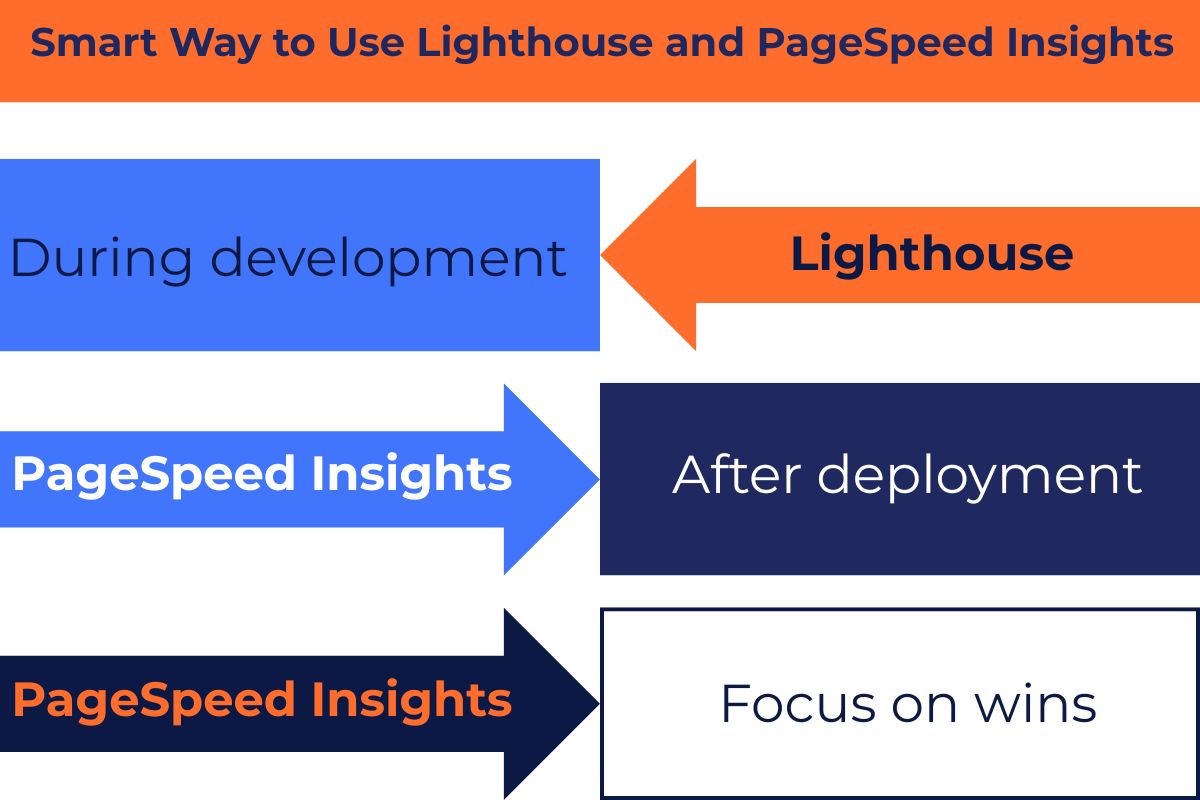If you’ve ever tried to speed up your website, you’ve probably stumbled across both Lighthouse and PageSpeed Insights. At first glance, they seem pretty similar — both are Google’s tools, both spit out performance scores, and both claim to help you make your site faster. But here’s the thing: they’re quite different, and mixing them up can send you down some pretty frustrating rabbit holes.
The Core Difference Between Lighthouse and PageSpeed Insights
Let me break this down in simple terms:
Lighthouse is like having a performance testing lab right in your browser. It’s an open-source tool that you can run locally or through the command line.
PageSpeed Insights is more like getting a full health report. It takes Lighthouse’s lab results and adds real-world data from actual users browsing the web through Chrome.
Think of it this way: Lighthouse is the microscope that examines your site under perfect conditions. PageSpeed Insights takes those findings and says, “But here’s what’s actually happening when real people visit your site on their phones while riding the subway.”

How Lighthouse Works
Lighthouse runs your website through a controlled testing environment. It simulates loading your page on a standard mid-range device with a decent internet connection, so you get consistent results every time. It checks five main areas:
- Performance (how fast things load)
- Accessibility (can everyone use your site?)
- Best Practices (are you following web standards?)
- SEO (Is your site search engine friendly?)
- Progressive Web App features (does your site work like an app?)
The beauty of Lighthouse is that you can test anything, even your local development site that nobody else can access yet. Pretty handy when you’re still building things.
How PageSpeed Insights Works
Here’s where it gets interesting. PageSpeed Insights uses Lighthouse to generate its lab data, but then it adds something crucial: real user data from Chrome’s massive database of browsing experiences. This gives you insights into how your site performs for actual visitors, not just in perfect testing conditions.
PSI also puts special emphasis on Core Web Vitals — those SEO ranking factors that Google actually uses to rank websites. So when you’re looking at PSI results, you’re seeing data that directly impacts your search rankings.
Pagespeed Insights vs Lighthouse: Which One Should You Actually Use?
Here’s the honest answer: you need both, but at different times.
Use Lighthouse when you’re:
- Developing or debugging your site
- Need quick, repeatable tests
- Working on a staging site that isn’t live yet
- Want to isolate performance issues without real-world noise
Use PageSpeed Insights when you’re:
- Checking how real users experience your site
- Optimizing for search engine positioning
- Measuring improvements over time with actual user data
Here’s a real scenario: imagine you’ve just launched a redesigned homepage. Lighthouse shows blazing fast load times — you’re feeling pretty good about yourself. But then PageSpeed Insights reveals that real users are experiencing slow interaction times. That’s your cue that something’s wrong in the real world, even though your lab tests look perfect.
Google PageSpeed Insights Website Versus Lighthouse in Browser — The Key Differences
When you test on the Google PageSpeed Insights website versus running Lighthouse directly in your browser, you’re actually getting different perspectives:
PSI’s web interface runs tests from Google’s servers using their specific testing conditions and incorporates that valuable real-user data when it’s available.
Lighthouse in Chrome DevTools runs right on your machine, letting you customize testing conditions, try different device simulations, and run multiple tests back-to-back without waiting.

This difference between Lighthouse and Pagespeed Insights matters a lot if you’re serious about technical SEO. Lab results alone won’t show you all the issues that real users face.
Why “Lighthouse Powering PageSpeed Insights” Confuses Everyone
You’ll often hear people say that Lighthouse powering PageSpeed Insights means they’re basically the same thing. That’s only half true. Yes, Lighthouse generates the lab portion of PSI’s data, but PSI’s real value comes from that field data — the real user experiences that Lighthouse can’t access on its own.
This is exactly why the difference between Lighthouse and Pagespeed Insights can be so confusing, and why their scores often don’t match up.
Common Mistakes That Actually Hurt Your SEO
I see these mistakes all the time, and they can really derail your optimization efforts:
- Obsessing over perfect scores — Getting a 100 on Lighthouse doesn’t automatically mean your users are happy. Focus on improving the actual user experience instead.
- Ignoring real user data — Lighthouse scores look great, but if PageSpeed Insights shows poor field data, that’s what Google cares about for rankings.
- Fixing things in the wrong order — Start with issues that impact both lab and field performance, like oversized images or bloated JavaScript files.
The Smart Way to Use Both Tools
Here’s what experienced SEOs actually do (and it works):
- Start with Lighthouse on your staging site — Fix the obvious problems before going live
- Validate with PageSpeed Insights on the live site — Confirm your fixes help real users
- Track changes over time — Use PSI’s comparison feature to see how your optimizations impact both lab and field SEO metrics

This approach ensures your technical improvements actually translate to better user experiences, which is what Google’s algorithm really cares about.
Why This Actually Matters for Your Long-Term SEO Success
Google’s getting smarter about rewarding sites that provide genuinely good user experiences. The algorithm increasingly factors in speed and stability because they directly correlate with user engagement and satisfaction.
By regularly monitoring both Lighthouse and PageSpeed Insights data, you’re staying ahead of competitors who might only focus on one or the other. It’s not just about loading faster — it’s about building a solid SEO foundation that keeps your rankings stable even when the competition heats up. This comprehensive approach is exactly what we recommend at Indexed Zone SEO for long-term success.
FAQ: Lighthouse vs PageSpeed Insights
1. Why do Lighthouse and PageSpeed Insights show different scores?
The difference between Lighthouse and Pagespeed Insights scores comes down to data sources. Lighthouse only shows controlled lab results, while PageSpeed Insights combines lab data with real-world user experiences from Chrome’s database. Real-world conditions like slow networks or older devices often result in lower PSI scores.
2. Which tool gives me more accurate results?
Both tools are accurate, but they measure different things. Lighthouse is perfect for consistent, repeatable testing under controlled conditions. PageSpeed Insights shows you what’s happening with real users, and that’s often more important for SEO.
3. Can I use Lighthouse when I’m offline?
Absolutely! Lighthouse works great in Chrome DevTools or the command line, even without internet access. This makes it perfect for testing local builds or staging environments. PageSpeed Insights needs an internet connection to analyze your page and pull in user data.
4. Does PageSpeed Insights always use Lighthouse data?
Yes, for the lab portion of its analysis. But remember, the real value of PSI comes from combining that lab data with actual user experience data that Lighthouse can’t provide on its own.
5. How often should I be running these tests?
Use Lighthouse frequently during development — it’s great for quick iterations and immediate feedback. For PageSpeed Insights, monthly checks work well for live sites to track Core Web Vitals and other ranking factors over time.
Your Action Plan: Making This Work Today
Ready to put this knowledge to work? Here’s what to do:
- During development: Run Lighthouse in your browser for fast feedback and quick fixes
- After deployment: Check PageSpeed Insights to see how real users experience your changes
- Focus on wins: Prioritize fixes that improve both lab and field metrics for lasting SEO benefits
The difference between Lighthouse and Pagespeed Insights isn’t about choosing one over the other. It’s about understanding when and how to use each tool to get the complete picture of your site’s performance — the kind of comprehensive approach that actually moves the needle on rankings and keeps them there.



